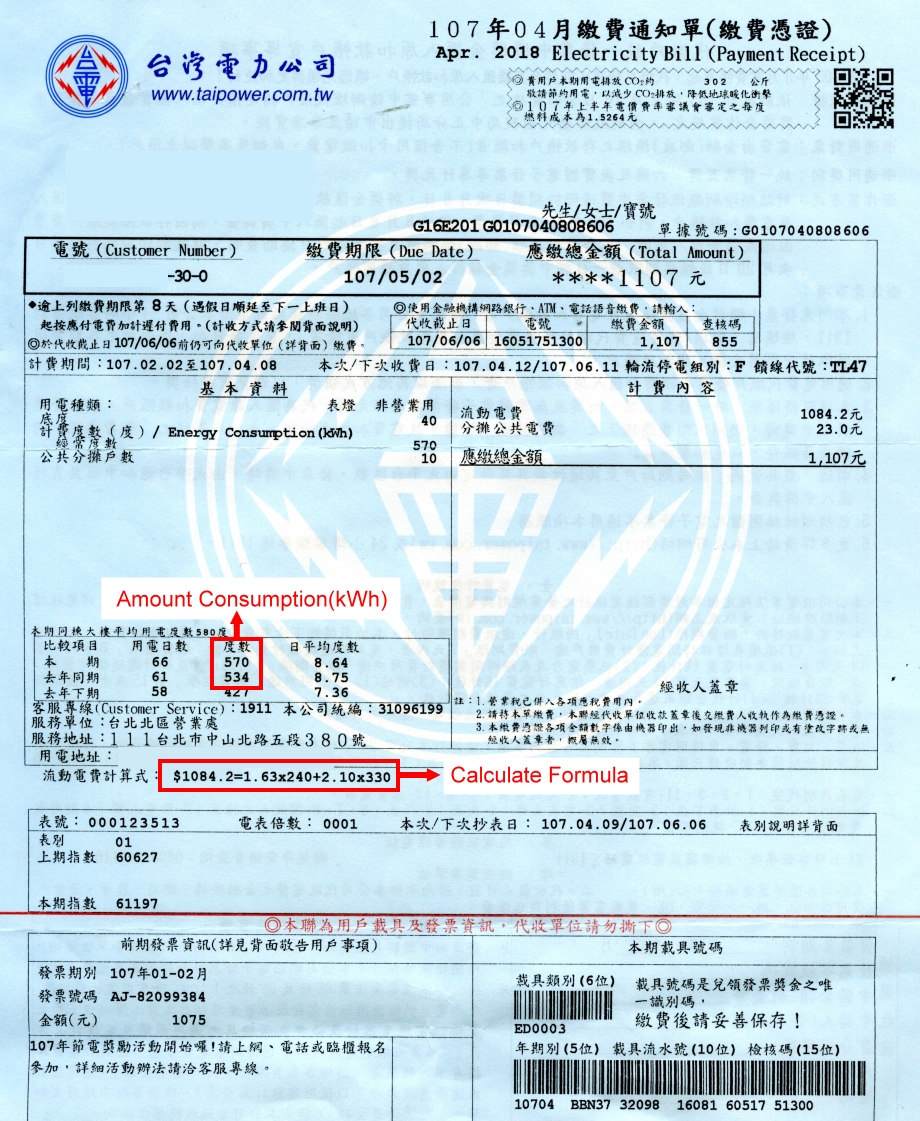|
 Household Guide ¢@ Reading Bill
Household Guide ¢@ Reading Bill

 How to read the bill?
How to read the bill?
¡·What is one degree of electricity?
Each electric unit consists of 1000 watts. We
typically consume 1 kWh of electricity every hour.
For example, 800 watts of air-conditioning is used for 10
hours, so it shares 800*10 = 8000 watts ¡E hours = 8000/1000
= 8 kWh
¡·A KWH is used to measure the amount
of electric units consumed in a typical household.
1 degree of electricity = 1000 watts ¡E hours =
1kWh ¡E hours
Electricity fees are usually measured progressively (x2)
nationwide. The more electricity you consume, the higher the
bill gets.
Seasonal fees (x1) are also included in the final bill. It
usually costs more between June to September than it does
from October to May.
|
Non-Commercial (per
month) |
Non-Summer |
Summer |
|
First under 120 kWh |
1.63 |
1.63 |
|
Next 121-330 kWh |
2.10 |
2.38 |
|
Next 331-500 kWh |
2.89 |
3.52 |
|
Next 501-700 kWh |
3.94 |
4.80 |
|
Next 701-1000 kWh |
4.60 |
5.66 |
|
Over 1000 kWh |
5.03 |
6.41 |
1 Progressive rates: Each KWH is
categorized into different ratings, each rating corresponds
to varying prices. The more electricity you consume, the
pricer the bill gets. This is to encourage people to consume
electricity wisely, as those who consume more ends up paying
more.
2 Seasonal Rates: Due to the scorching heat in the summer,
most people result to indoor air conditioning to avoid the
heat. More electricity is consumed, and the cost to provide
a steady supply of electricity is higher than usual. In
order to balance the additional costs and to raise awareness
towards the amount of energy consumed, seasonal ratings are
applied with varying prices.
¡·How does your bill work?
Each domestic unit is receives an electric bill once every
two months. For the 120 KWH/ month, it costs 1.63 TWD/ KWH,
with the ratings up to 2.38 TWD/ KWH in the summer. So for
the first two months before the summer, it costs 120 x 2 x
1.63 NTD. As for the two months during the summer, it costs
210 x 2 x 2.38 NTD. The same logic applies to other months.

¡·Comparing
electric fees between different countries:
Ratings for domestic electric fees have gone lower for 11
times, from 2.7798 NTD / KWH to 2.0533 NTD/ KWH, from 1983
to 2015. Although costs for fossil fuels like coal, oil and
gas have gone high, an IEA study in 2017 suggests that the
electricity fees in Taiwan remain generally low as compared
to neighboring countries. The nation scored the second
lowest for domestic consumption and the seventh lowest for
industrial consumption.
¡·How
do we check the meters?
There are five circles with numbers on the electricity
meters. From the right to the left, digits go from singles,
tens, hundreds, thousands to ten thousands. The hands on the
meter go from left to right, clockwise, counter clockwise,
clockwise, counter clockwise, clockwise. As long has the
hand does not get pass the next digit, we go for the smaller
numbers in between.
Monthly KWH measurement = where the hand was lastly seen -
where the hand is currently resting
¡·How
many turns per meter?
When electricity is consumed in a domestic household, it
passes through the meters and propels it to move. The meter
then displays the Kh value, which basically tells us how
much watts are being consumed within each circle the hands
turn. For example, if you see Kh=7.2 on the meter, this
means that forever circle the hands on the meter turns, it
would consume 7.2 watts. This means that for each KWH, the
hands on the meter have to turn 1000/ 7.2=138.9 circles. The
mechanical meter needs to go through 138.9 circles to reach
one KWH.
 |